Call our helpline
0300 180 0028Siri can be activated via a long-press on the ‘Home’ button or by saying “Hey Siri” if you have enabled this feature.
Newer iPhones and the latest iPad Pros can use the “Hey Siri” command when running on battery power, older devices will need to be attached to mains power in order to use the command. Your device will need to be connected to the internet in order for ‘Siri’ to work.
This article is split in four sections:
Examples of what Siri can do
You can ask ‘Siri’ to perform a wide variety of tasks on your device such as:
- Make phone calls and Facetime calls
- Send emails and text messages
- Set calendar events and reminders
- Set alarms and timers
- Obtain weather forecasts
- Give directions on Apple Maps
- Perform calculations
- Open applications
- Open accessibility options
- Turn on certain accessibility features such as ‘VoiceOver’.
- Change setting on your device such as changing the brightness and volume or toggling Wi-Fi on or off.
- Perform web searches
- Play music, including particular artists, songs or albums
- Control smart home devices
- Siri now also works with a growing number of third-party apps such as Skype, Pinterest and Paypal
How to enable Siri
‘Siri’, and the ‘Hey Siri’ command can be enabled during the setup process when you first use your new device.
If you chose not to set up Siri initially and now want to, or if you wish to change some of the ‘Siri’ settings you can do so in the ‘Settings’ app.
- Tap the ‘Settings’ icon on your home screen. Fig 1.
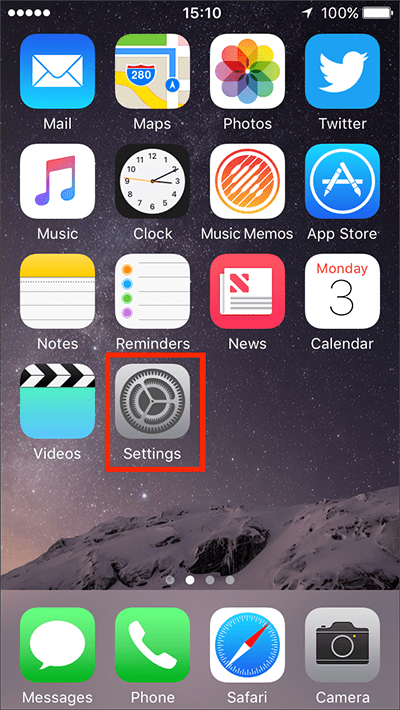
Fig 1 - Tap on ‘Siri’. Fig 2.
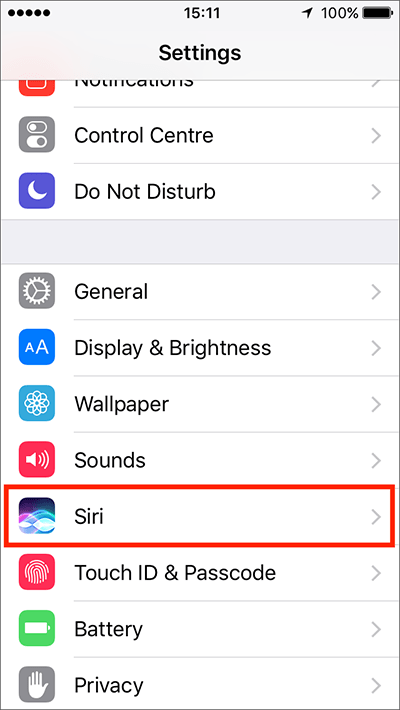
Fig 2 - If ‘Siri’ is not already enabled, tap the toggle switch next to ‘Siri’ to turn it on Fig 3. Once enabled, you can access ‘Siri’ by pressing and holding the ‘Home’ button.

Fig 3
When you turn ‘Siri’ on you will receive an alert warning you that ‘Siri’ sends information to Apple in order to process your request. If you are a happy to proceed, tap ‘Enable Siri’ or press ‘Cancel’ if you don’t wish to enable ‘Siri’ at this time. Fig 4.

Fig 4
When ‘Siri’ is enabled you will see several settings you can change:
Access When Locked
- This feature is enabled by default and allows you to use ‘Siri’ even when your device is locked. To turn this feature off, tap the toggle switch next to “Access When Locked” Fig 5.

Fig 5
“Hey Siri”
- If you would like to use the “Hey Siri” command to activate ‘Siri’, tap the toggle switch next to ‘Allow “Hey Siri”’. Fig 6.
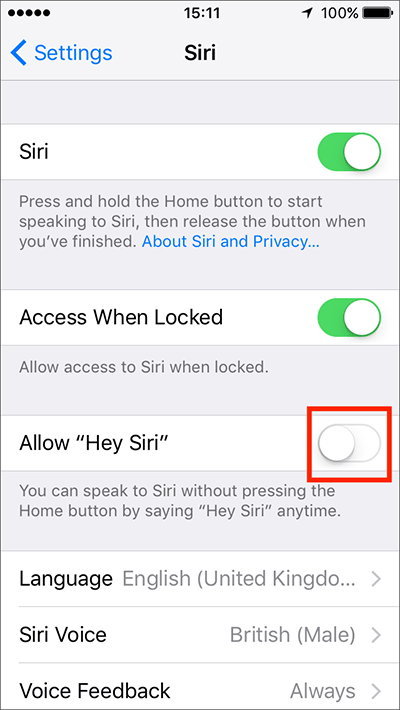
Fig 6
You will now be prompted to train your device to understand your voice better:
- Tap on ‘Continue’ to begin, (see the first panel of Fig 7).
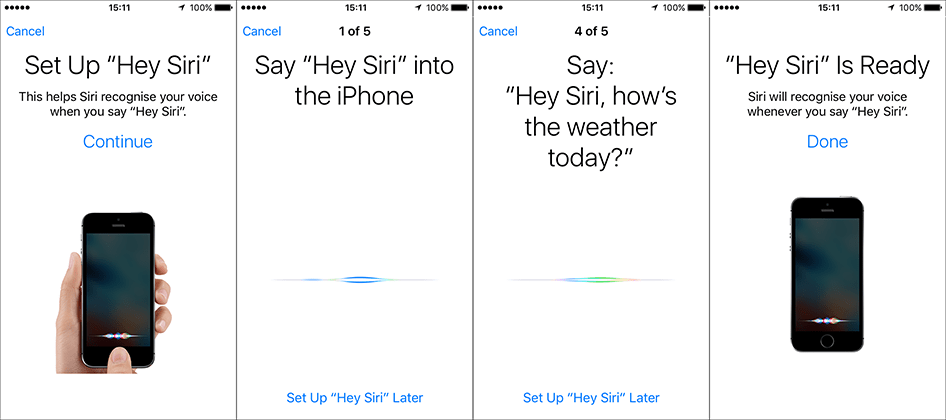
Fig 7 - First, you will be asked to say “Hey Siri” three times(see the second panel of Fig 7).
- You will then be prompted to ask a couple of standard ‘Siri’ queries (see the third panel of Fig 7).
- Click ‘Done’ on the ‘“Hey Siri” Is Ready’ screen to return to ‘Siri’ settings (see the fourth panel of Fig 7).
Tip: If you want to retrain your device to better recognise your voice when you say the “Hey Siri” command, just tap the toggle switch next to ‘Allow “Hey Siri”’ twice (to turn the feature off and back on), then go through the “Hey Siri” setup steps again.
Language
- By default ‘Siri’ uses the language that you chose when setting up your device. If you would like to change the language ‘Siri’ uses, tap on ‘Language’ Fig 8.
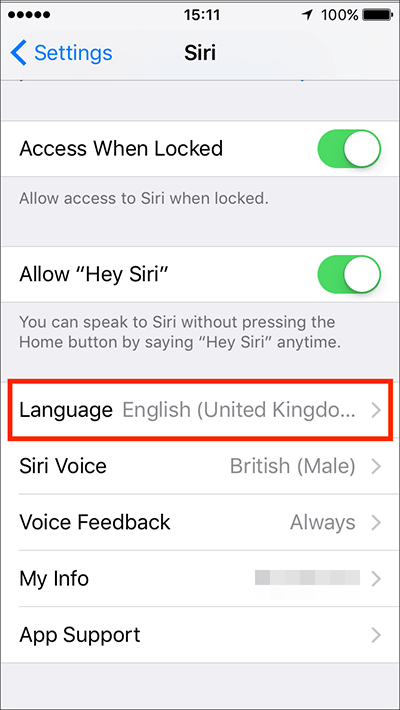
Fig 8 - On the next screen, tap on a language to select it. You will receive an alert warning that the “Hey Siri” feature will be turned off. Fig 9.
- To teach ‘Siri’ your voice in the new language, turn ‘Hey Siri’ back on and go through the setup steps again.

Fig 9
Siri Voice
- You can change ‘Siri’s’ voice to male or female and you can pick from several accents. To change the voice ‘Siri’ uses, tap on the toggle switch next to ‘Siri Voice’. Fig 10.
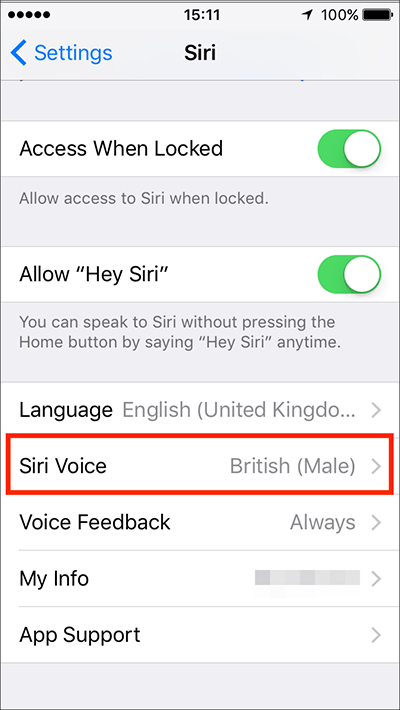
Fig 10 - Tap on the accent and gender you wish to use. (Fig 11). If you are changing the accent or gender your device will automatically download a voice pack for it. Fig 11.
Note: Please be aware that if you are using a mobile data connection downloading a voice pack will use up some of your data allowance. We recommend being connected to Wi-Fi when you download voices.
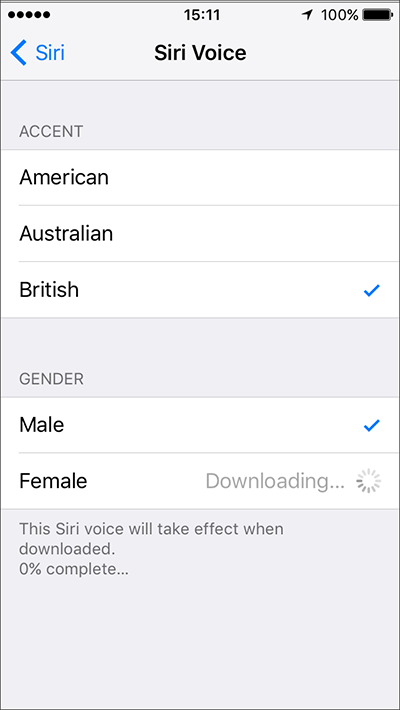
Fig 11
Voice Feedback
By default, when ‘Siri’ answers your query you will receive both spoken and visual, on-screen feedback.
You can chose from:
- Always On
To receive spoken and visual feedback, even when your phone is in silent mode. - Control with Ring Switch
When your phone is in silent mode you will only receive visual, on-screen feedback. Note: You will still receive spoken feedback if you use the “Hey Siri” command or if your device is connected to a Bluetooth audio device, headphones, or CarPlay. - Hands-Free Only
You will only receive spoken feedback when you use the “Hey Siri” command or if your device is connected to a Bluetooth audio device, headphones or CarPlay.
To change these settings, tap on ‘Voice Feedback’. Fig 12.
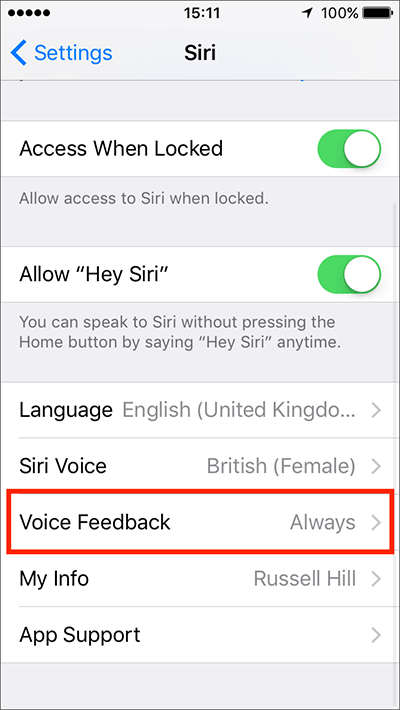
Fig 12
- Tap on the feedback option you would like to use. Fig 13.
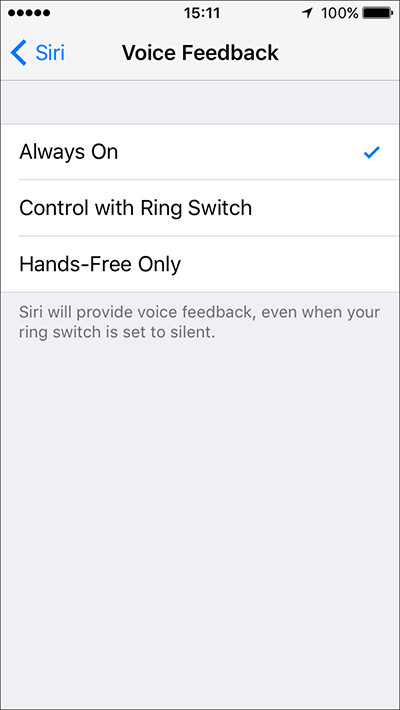
Fig 13
My Info
This is where you can tell ‘Siri’ who you are by selecting your contact card from the ‘Contacts’ address book. ‘Siri’ uses this information when answering location based queries such as “Give me directions home”.
- To use your contact details, tap on ‘My Info’ (Fig 14) and select your name from the list of contacts that appears.
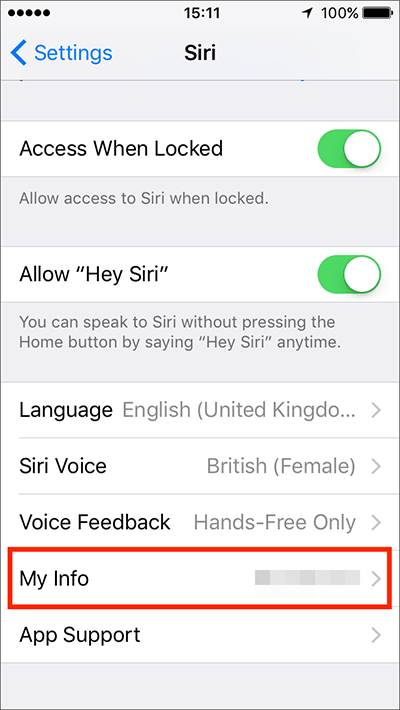
Fig 14
Note: If you haven’t yet created a contact card for yourself, open the ‘Contacts’ app on your device, add your details and then return to the ‘My Info’ section in ‘Siri’ settings.
App Support
You can now use ‘Siri’ to perform actions within some third-party apps, such as WhatsApp, Paypal and Pinterest.
- To see which of your installed apps ‘Siri’ can interact with and to allow ‘Siri’ access to them, tap on ‘App Support’. Fig 15.
Fig 15 - Tap on the toggle switch next to any app to allow you to interact with the app using ‘Siri’. Fig 16.
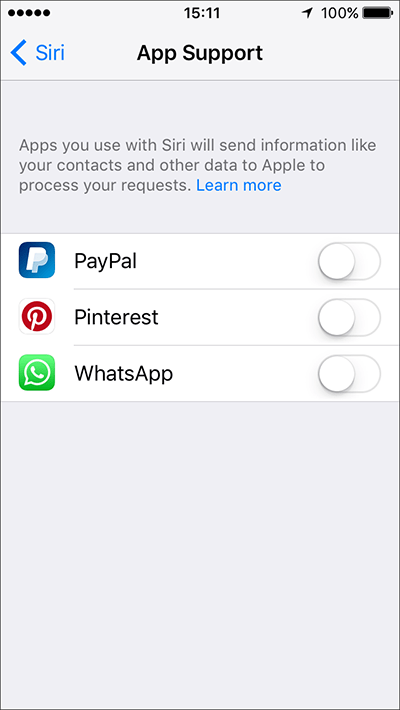
Fig 16
Note: To find out how you can use ‘Siri’ with a particular app, see “What can you do” under the ‘Using Siri’ section below.
When you are happy with your settings, either tap the back button in the top left of the screen to return to the main settings screen or press your device’s ‘Home’ button to return to the home screen.
Using Siri
You can launch ‘Siri’ by pressing and holding your device’s ‘Home’ button or by saying the “Hey Siri” command if you have enabled it (see the ‘How to enable Siri’ section above).
Note: Newer devices (iPhone 6s onwards (including the iPhone SE) and iPad Pro from 2017 onwards) can use the “Hey Siri” command when running on battery power. Older devices will need to be connected to mains power in order to use “Hey Siri”.
When launched, ‘Siri’ will ask ‘What can you I help you with?” and you will see an animated sound wave at the bottom of the screen to show Siri’ is listening. Fig 17.
You can now ask your query or state your request. In our example, below, we asked ‘Siri’ the time (see the second panel of Fig 17).
We received a spoken and visual response which you can see in the third panel of Fig 17.
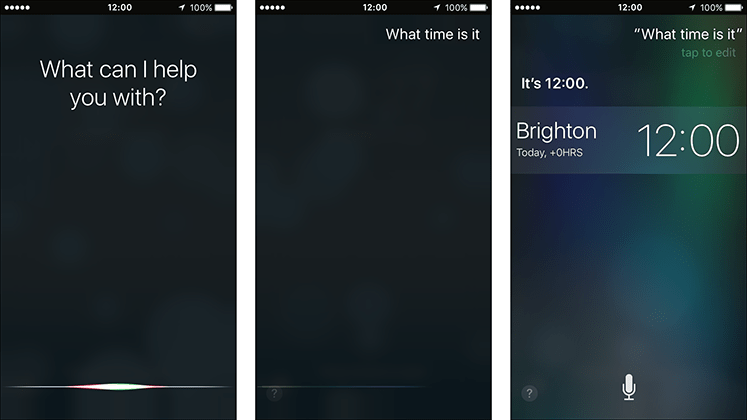
Fig 17
If you would like to edit a query using the keyboard (for instance, if ‘Siri’ mishears you), tap the ‘Tap to edit’ button that appears under your original query (see the first panel of Fig 18).
Type your amendments (see the second panel of Fig 18) and press ‘Done’ on the keyboard. ‘Siri’ will now answer your amended query (see the third panel of Fig 18).
In our example, we asked ‘Siri’ the time. We then amended our query to ask what the time was in Australia.
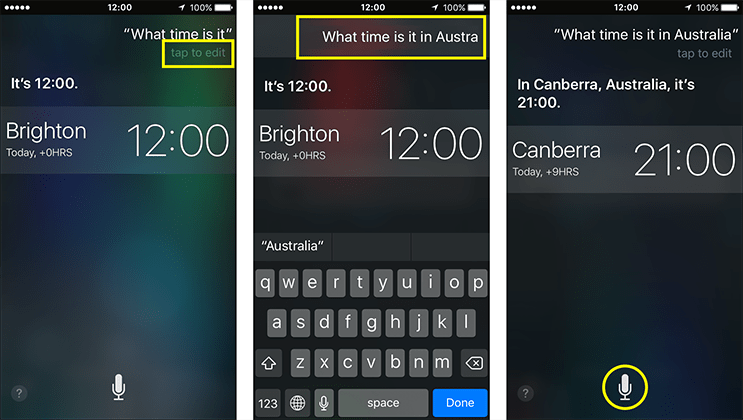
Fig 18
Tip: If you want to ask another query while ‘`Siri’ is still open, tap the microphone icon, (that appears once a query has been answered) and start speaking, (see circled in the third panel of Fig 18).
“Hey Siri, what can you do?”
To find out more about what ‘Siri’ is capable of doing on your device just launch ‘Siri’ and ask “What can you do?” (Fig 19). You will be presented with a list of apps that ‘Siri’ is able to interact with.
Tap any app name in the list to see how ‘Siri’ can be of assistance and to see examples of how to phrase your queries. Fig 19.

Fig 19
Another way to get tips is by launching ‘Siri’ but not asking a query.
Press and hold the ‘Home’ button and keep it pressed until the “Go ahead I’m listening” screen appears.
Lift your finger from the ’Home’ button and ‘Siri’ will show you a screen of query suggestions. There are several screens of suggestions so just let it play to see them all. Fig 20.

Fig 20
Third Party apps
Ask ‘Siri’ “What can you do?” as above. Scroll to the bottom of the list of apps to see the third-party apps that you have that will work with ‘Siri’.
Tap an app name to see suggestions of how you can use ‘Siri’ to interact with it. Fig 21.
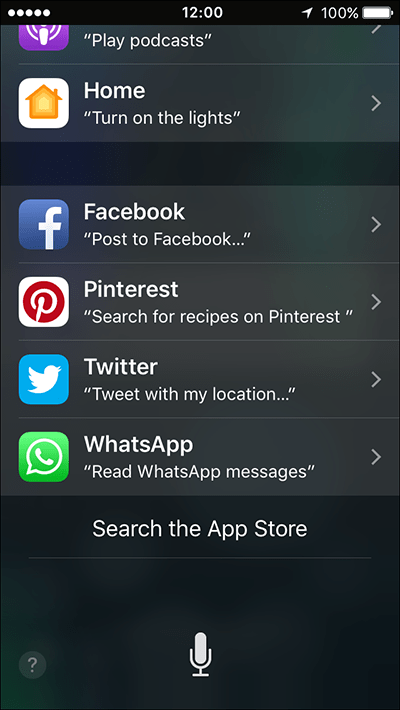
Fig 21
Examples of using Siri
Add a new Calendar event
In our example below, we will ask ‘Siri’ to add a new ‘Calendar’ entry for a dentist appointment.
- Launch ‘Siri’ by pressing and holding the ‘Home’ button or by saying “Hey Siri”, then say “Add a calendar event for dentist appointment”.Fig 22.
- ‘Siri’ will responding by asking for the date and time of the appointment. When the sound wave appears at the bottom of the screen (indicating that ‘Siri’ is listening) give ‘Siri’ the details. Fig 22.
- In our example, we have given the date as 21st July and the time as 2.30pm. Fig 22.
- ‘Siri’ gives spoken and visual confirmation of the event details and ask you to confirm them before adding the event to your calendar.
- When the sound wave appears again to indicate ‘Siri’ is listening say “Yes” or “Confirm”, or tap the ‘Confirm’ button on the screen. Fig 22.
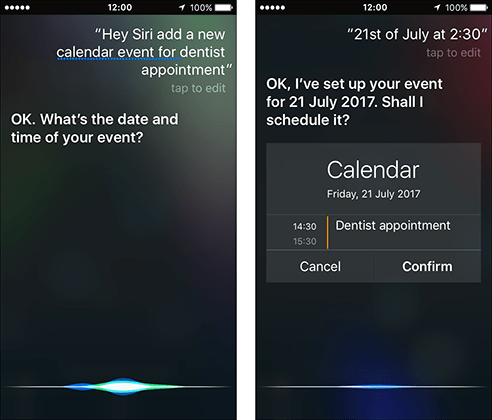
Fig 22
Add a new Reminder
In our example below we will ask ‘Siri’ to set a reminder to buy milk the following day. In this example, we have asked the query in one sentence using the “Hey Siri” command.
- Say “Hey Siri set a reminder to buy milk tomorrow at 5pm.” Fig 23, screenshot 1.
- ‘Siri’ immediately sets the reminder and gives spoken and visual confirmation of the reminder that has been created. Fig 23, screenshot 2.
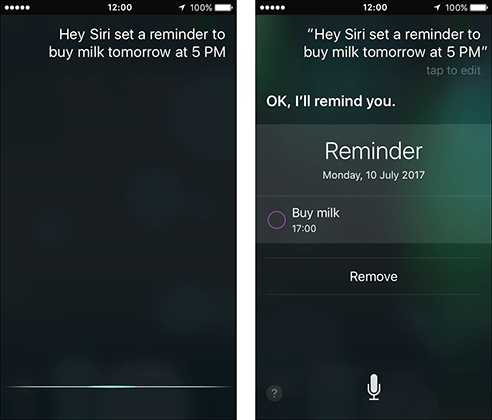
Fig 23
Ask for directions
If you ask for directions, ‘Siri’ will open the Apple Maps app and show your route plotted on the map. In our example below, we ask for directions to London. Because we have only asked for the end destination (London), ‘Siri’ uses our current location for the starting point.
- Launch ‘Siri’ by pressing and holding the ‘Home’ button or by saying “Hey Siri”
- Say “Give me directions to London”. Fig 24.
- ‘Siri’ opens the Apple Maps app with the route already plotted. Fig 24.
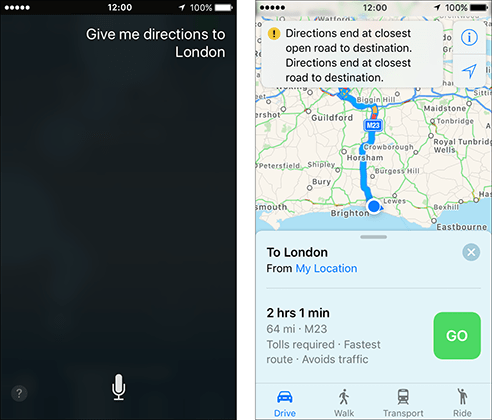
Fig 24
More information:
Apple’s guide to using Siri: https://www.apple.com/uk/ios/siri/
iMore’s Siri help guide: https://www.imore.com/siri-ultimate-guide
iMore’s guide to using Siri with your Contacts: https://www.imore.com/how-call-message-and-email-your-contacts-using-siri